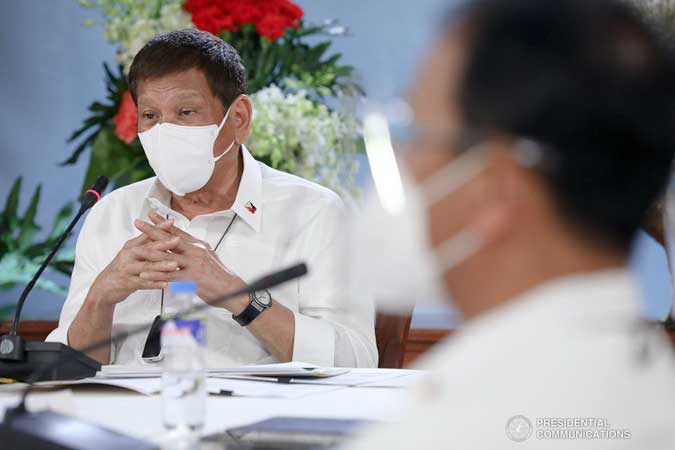
Numbers Don’t Lie
By Andrew J. Masigan

The old adage, “put your money where your mouth is,” is as true today as it was when it was first written in 1930. One can make promises and profess support for all sorts of causes until they are blue in the face. None of it matters until they put money behind their words. The areas and causes where one spends their money are the definitive reflection of their true priorities.
President Duterte is a difficult character to figure out. Not only is he inclined to utter words impulsively to pander to the crowd, we have also learned that he has a penchant for denying things he said before (even if they were recorded). When trapped by his own utterances, it is not beyond him to claim that they were all a joke.
During the election campaign and up to his first year in office, President Duterte made grand populist promises to hypnotize the nation into a euphoric state of optimism. He promised a golden age of infrastructure where spending on roads, bridges, and ports would amount to no less than 7% of GDP. He promised to elevate our quality of life by increasing spending on mass housing and social development projects, including education. He promised to end corruption, end illegal drugs, end social injustice, end political dynasties, and to enforce judicial reforms.
By his own admission, he failed to control corruption and failed to end the drug trade. Two keystone promises broken, right there. Ironically, corruption is worse today than it had been in decades, while the war on drugs proved to be destructive and damaging rather than restorative.
He also failed to end social injustice and political dynasties. Social injustice (and inequality) is at its worst since the Marcos years and political dynasties are more entrenched than ever. That makes four keystone promises broken.
On the surface, it would seem that the Duterte Administration succeeded in infrastructure development. But looking at the statistics, it is not the case. At the beginning of its term, the Duterte government promised that infrastructure spending, as a percentage to GDP, would reach 5.4% in 2017, 6.1% in 2018, 6.8% in 2019, and 6.9% in 2020. After reneging and lowering the spending quota two times, data shows that the actual spending ratio stood at only 5.1% in 2017, 6.3% in 2018, 5.5% in 2019, and 4.6% in 2020.
While actual spending on infrastructure falls short of its twice-adjusted targets, it is even over stated. This is because this government re-defined what constitutes infrastructure. “Infrastructure,” in the context of nation building has always referred to transport and logistics-related projects. What they did was to include science-related and technology-related projects as well (which are separate line items in the national budget). Thus, the real spending roads, bridges, and ports is really much lower than what government purports it to be.
The Duterte administration has also claimed credit for projects that were signed and sealed well before its time. This includes the Skyway stage 3 (approved 2014), LRT-2 Extension (approved 2012), NLEX-SLEX Connector Road (approved 2013), CALAX (approved 2015) … and the list goes on.
What is most disturbing, however, is that infrastructure spending was used as a tool for patronage politics. The General Appropriations Acts shows that the budget of the Department of Public Works and Highways (DPWH) increased from P580.87 billion in 2020 to P694.82 billion in 2021 (a P113.95 billion increase). But looking closely at the line items, you will find that “Local Programs,” which is another word for pork barrel funds, increased from P198.82 billion to P280.62 billion, an P81.8 billion increase! Pork barrel finances patronage-driven projects by local politicians, like basketball courts. Appropriating 40% of the DPWH budget for this purpose is scandalous. It is the amount Mr. Duterte is effectively paying to buy loyalty.
Again, I emphasize — the areas which this administration appropriates the national budget for is a reflection of its priorities. That said, it is clear that social development and social welfare are at the bottom of this government’s concerns.
Spending on education actually decreased by P30 billion in 2019 compared to the year prior. It increased by a small increment in 2020 and 2021. Meanwhile, the budgets of the Departments of Social Welfare and Development (DSWD) and Health (DoH) remained practically static from 2017 to 2020.
What stings acerbically is that following the pandemic, government appropriated the lowest budget among our ASEAN peers to ease the plight of our people. Financial assistance (ayuda) last year was grossly insufficient and painfully scarce. Economic relief to micro-, small-, and medium-sized enterprises (MSMEs) was hardly felt. Worse, the conditional cash transfers program of government was cancelled for 2021.
For perspective, Mr. Duterte’s government spent 3.5% of GDP on its COVID-19 response and civilian support. Thailand spent 9.6% of GDP, Malaysia 4.9%, Indonesia 3.8% and Vietnam 3.6%. I reckon we have the most unsympathetic government in the region.
Even today, government remains liberal in enforcing restrictions but is unable to provide financial subsidies to displaced workers and MSMEs. Civil society is left on its own to survive the financial pangs of the pandemic.
So which sector received the sharpest increases in budget appropriation?
Topping the list is President Duterte’s contingency fund which increased five-fold. From P2.5 billion in 2016 (last year of the Aquino administration), it catapulted to a whopping P13 billion in 2020. These funds are used for intelligence, communications, and other “confidential operations.”
The second office that received a sharp budget spike is the Philippine National Police (PNP). The PNP’s budget increased by 123% from P76 billion in 2016 to P169.7 billion in 2021.
The third largest beneficiary is the Armed Forces of the Philippines (AFP) whose budget increased from P62.2 billion in 2016 to P120.7 billion in 2021, a 94% increase.
So, why did the AFP and PNP receive the highest increase in budget appropriations? A noted political analyst opined that it is only the military and the National Police (along with Supreme Court) that have the power to neutralize President Duterte’s abuses. By filling their coffers with more funds than they have ever seen before, Malacañang had effectively neutralized them.
As I look at how the nation’s financial resources are spent, it is clear to me that the national budget is/was used not as a tool for social or economic development, as it should be. Rather, the budget has always revolved around President Duterte himself. It served his needs, his political agenda, his personal operations, and the perpetuation of the Duterte brand.
***
Thank you to the Institute for Leadership, Empowerment and Democracy for providing facts and figures for this piece.
Andrew J. Masigan is an economist
Facebook@AndrewJ. Masigan
Twitter @aj_masigan